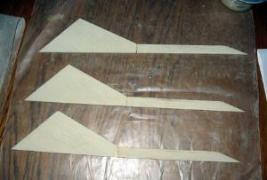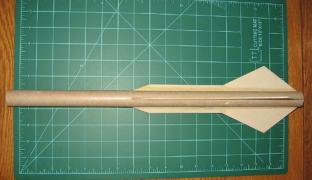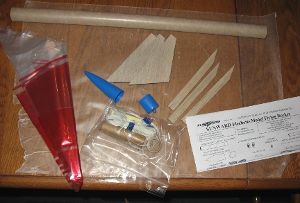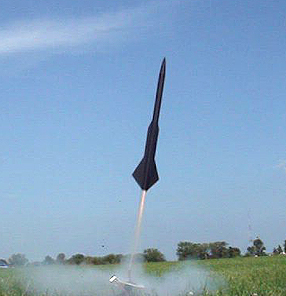| Construction Rating: | starstarstarstarstar_border |
| Flight Rating: | starstarstarstarstar |
| Overall Rating: | starstarstarstarstar |
| Manufacturer: | Sunward Aerospace  |

Brief:
This is a BT-50 (24mm) based rocket that uses 18mm engines. The name of the rocket comes from the French word for
"dart" and the design is modeled after a military projectile having the form of a small metal dart. A
flechette normally has a sharp-pointed tip and a tail with several vanes to stabilize it during flight. These normally
don't have propulsion systems and are dropped/launched from other weapons.
Construction:
The rocket kit includes one BT-50 sized body tube, a plastic nose cone (mine was blue), fin material for three
composite (made up of more than one piece of balsa) fins, the 18mm motor mount, elastic shock cord (using a tri-fold
mount), 18" plastic parachute and a launch lug. No decals are supplied with this kit.
This was the first Sunward kit that I've built so I wasn't immediately used to the instructions. The instructions appeared to be printed out on normal letter sized paper and included many handmade drawings and measurements. Some aspects of the individual steps were a touch misleading (especially in the motor mount section), but if you've built kits before, then it shouldn't be too hard to figure out.
The balsa quality was good and since the fins are each constructed of two separate pieces of wood (for strength/grain orientation), I chose to pre-assemble the fins on wax paper to avoid alignment/warping issues. I used Elmer's Fill 'n' Finish on the completed fins in efforts to try and fill the gap between the fin sections and seal the grain.
Once the fins were assembled, I glued them onto the body tube. Since the fins are rather long (make sure your fin lines are drawn to around half the tube length), it's a challenge to keep them perfectly aligned and contacting the body tube. A double glue joint method works well here to instantly bond them to the tube and keep them from sliding around during the drying process.


The nose cone went together easily although it's a different design than most other plastic nose cones I've used (like Estes). Instead of the cone and shoulder being one single piece and then gluing on the back "cap" with the shock cord loop, the cone itself is one piece and the shoulder-cap is another. I thought I'd have a hard time centering the shoulder within the tapered cone, but it all went together very easily.
 The shock cord mount is done with the paper tri-fold mount method and appears to be very
solid. A Kevlar®
leader style mount could be added easily by tying it around the engine hook and filing a slot in the top CR to allow
for the thread to pass through. I didn't do this extra step and built it as stock. I liked the fact that the included
shock cord seemed to be plenty long (at least twice the length of the rocket).
The shock cord mount is done with the paper tri-fold mount method and appears to be very
solid. A Kevlar®
leader style mount could be added easily by tying it around the engine hook and filing a slot in the top CR to allow
for the thread to pass through. I didn't do this extra step and built it as stock. I liked the fact that the included
shock cord seemed to be plenty long (at least twice the length of the rocket).
The launch lug attaches on the fin's joints. I tapered the front of the lug to make it look more weapon-like and made fillets on it with white glue. For whatever reason I had trouble with bubbles in the launch lug fillets so I ended up skimming those joints with FnF prior to painting. It worked pretty well and looks smooth.
Finishing:
There are no decals with this kit, which doesn't bother me, so finishing pretty much involves painting.
The package shows a picture (courtesy of the US military) of a Flechette with camouflage markings. Since I fly in a large park field and this is a very light rocket, I anticipated problems with losing a camo-painted rocket in the tall grass, so I chose to paint my model satin black. The paint turned out very well and looks stealthy.
In the future, I may do an "urban camo" theme with orange and light blue added on top of the black.
The rocket itself is attractive and if you turn it upside down it bears a striking resemblance to a medieval maul.
Construction Rating: 4 out of 5
 Flight and Recovery:
Flight and Recovery:
For the first flight, I loaded my Flechette up with an Estes A8-3. There was a bit of wind at the field and since the
rocket is light, I chose to use a 12" parachute instead of the 18" model it came with.
On the A8-3, the rocket shot off the pad quickly and flew straight and true. My friends were surprised by the model's speed and altitude on such a small engine (probably around 400 feet or so). Recovery was uneventful on the 12" chute and the rocket came down around 50 feet from the pad.
For the second and third flights, I used B6-4 engines. Once again I was surprised by this model's acceleration and altitude. It quite simply scoots off the pad and streaks skyward with little effort. I would estimate that the Flechette went upwards of 600-700 feet on this engine. Both times the rocket came back reliably and landed safely in the short grass with no damage at all. Sunward claims upward of 1000 feet with a C engine and that appears completely reasonable given the light weight of this model.
Flight Rating: 5 out of 5
Summary:
In summary this is a unique looking military-themed kit that's cheap, easy to build, and very lightweight. The
Flechette offers sporty performance and cheap launches on 18mm engines.
Overall Rating: 5 out of 5
 |
 |
Flights
 |
 |